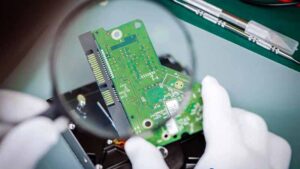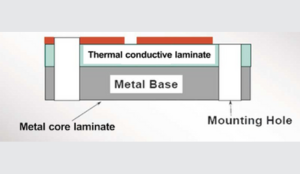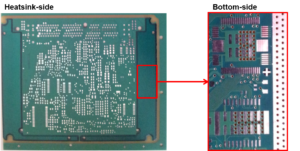HAST
The highly accelerated temperature and humidity stress test (HAST) is a highly accelerated method of electronic component reliability testing using temperature and humidity as the environmental parameters. HAST is also known as the pressure cooker test (PCT) or unsaturated pressure cooker test (USPCT).
Its purpose is to evaluate a test sample’s humidity resistance by increasing the water vapor pressure in a test chamber to an extremely high level above the partial water vapor pressure inside the test sample. This process temporally accelerates the infiltration of moisture into the sample.
HAST test standards
HAST is a more accelerated version of accelerated humidity-resistance testing. Compared to high-temperature/high-humidity testing (at 85°C/85% RH), HAST causes more component contact due to moisture-driven corrosion and more insulation deterioration. HAST is done mainly on plastic-sealed components.
The table that follows shows the most common HAST-related test standards. The test is performed at a specified temperature and relative humidity, or pressure. The atmosphere normally has a temperature of at least 100°C, in a state of water vapor pressurization.
HAST is sometimes classified as a combined test when pressure is also considered as an environmental parameter. There are saturated and unsaturated varieties of HAST. The former is typically done at conditions of 121°C and 100% RH, and the latter at conditions of 110, 120 or 130°C and 85% RH.
Tests done with the electronic component’s power on are usually the unsaturated type. HAST is an extreme test, with an acceleration factor of anywhere from tens to hundreds of times under conditions of 85°C and 85% RH. This extreme acceleration makes it important to check failure modes.
Table 1 Common HAST-related standards
| Name | No. (Year/month of inception) | Type* | Mainly used for: | Example test conditions | ||||||||||
| Temp ( Degree C) | RH (%) | Test duration (hours) | ||||||||||||
| IEC (International standard) | 60068-2-66 (1994/06) | U | Compact electric/electronic Components (mainly non hermetically sealed components) | I | II | III | ||||||||
| 110 | 85 | 96 | 192 | 408 | ||||||||||
| 120 | 85 | 48 | 96 | 192 | ||||||||||
| 130 | 85 | 24 | 48 | 96 | ||||||||||
| 60749-4 (2002/4) | U | Semiconductors | 130 | 85 | 96 | |||||||||
| 110 | 85 | 264 | ||||||||||||
| JESD (JEDE US industrial standard) | 22-A102-C (2008/6) | S | Evaluating humidity resistance of non-hermetically sealed semiconductor devices | A | B | C | D | E | F | |||||
| 121 | 100 | 24 | 48 | 96 | 168 | 240 | 336 | |||||||
| 22-A110C (2009/1) | U | Evaluating reliability of non-hermetically sealed semiconductor devices (with voltage application) | 130 | 85 | 96 | |||||||||
| 110 | 85 | 264 | ||||||||||||
| 22-A118 (2008/6) | U | Evaluating reliability of non-hermetically sealed semiconductor devices (without voltage application) | 130 | 85 | 96 | A | ||||||||
| 110 | 85 | 26 | B | |||||||||||
| JIS (Japanese industrial standard) | C60068-2-66 (2001/11) | U | Compact electronic components (mainly non-hermetically sealed components | I | II | III | ||||||||
| 110 | 85 | 96 | 192 | 408 | ||||||||||
| 120 | 85 | 48 | 96 | 192 | ||||||||||
| 130 | 85 | 24 | 48 | 96 | ||||||||||
| JEITA (Japanese domestic industrial standard) | ED-4701/100 Method 103 (2001/8) | U | Evaluating durability of semiconductor devices used or stored in high-temperature/ high-humidity atmospheres | 110 | 85 | 192 | ||||||||
| 120 | 85 | 96 | ||||||||||||
| 130 | 85 | 48 | ||||||||||||
HAST (Highly Accelerated Stress Test)
Typical HAST control methods are wet-and-dry bulb temperature control, unsaturated control, and wetting saturation control. Wet-and-dry bulb temperature control measures and controls the test chamber temperature and humidity directly with a wet-and-dry bulb temperature sensor. Wetting saturation control and unsaturated control are used for testing under a condition of 100% relative humidity.
The mechanism by which condensation forms on the test sample varies according to the control method. When using wetting saturation control for testing under a condition of 100% relative humidity, the test chamber heater is turned off, and only the humidifying heater is controlled. The environment resembles water being boiled in an airless atmosphere. When using unsaturated control, the test chamber heater being switched on causes a slight inclination toward unsaturation. Whether condensation forms on the test sample surface will be determined by the type of test sample and the humidity during the temperature/humidity rise and fall. For this reason, common standards besides JEDEC (such as IEC and JIS) specify only a relative humidity of 85%. We therefore recommend using test chambers only with full-condensation wetting saturation control, or wet-and-dry bulb temperature control.
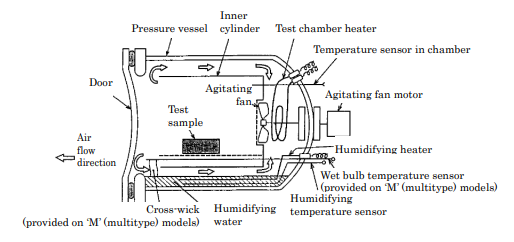
HAST test chamber structure
Below is a conceptual diagram of a constant temperature/humidity chamber. The water vapor pressure in the chamber is measured by a wet-and-dry bulb thermometer. This instrument works on the principle that the evaporation rate of water varies according to the quantity of water vapor in the surrounding gas. It measures the wet bulb temperature, a different measurement of humidity from dew point (except when the humidity is 100%).
Relative humidity in a constant temperature/humidity chamber (25°C/60% RH)
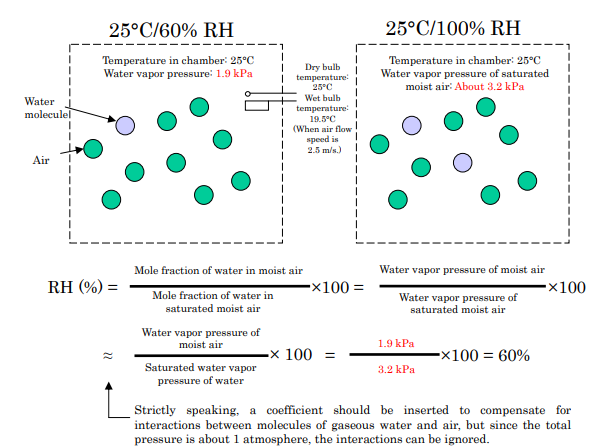
Constant temperature/humidity chamber relative humidity schematic diagram A
Concept of Relative Humidity in a Constant Temperature/Humidity Chamber
In an 85°C/85% RH environment, the water vapor partial pressure and air partial pressure are each about 50 kPa.
Relative humidity in a constant temperature/humidity chamber (85°C/85% RH)
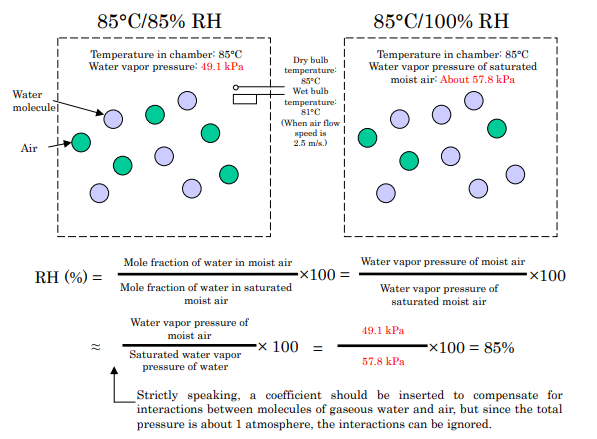
Constant temperature/humidity chamber relative humidity schematic diagram B
HAST Relative Humidity Concept
Under these conditions, the HAST environment resembles water being boiled in an airtight space. The HAST relative humidity is defined by the formula below in IEC 60068-2-66. The water vapor pressure in the chamber is calculated by measuring the humidifying water temperature or wet bulb temperature and considering that temperature to be the same as the dew point.
This method assumes that the test space is filled only with water vapor. It has been shown experimentally that the humidifying water temperature, wet bulb temperature and dew point are roughly the same in a stable-period HAST environment of high temperature, humidity, and pressure.
HAST relative humidity (120°C/85% RH)
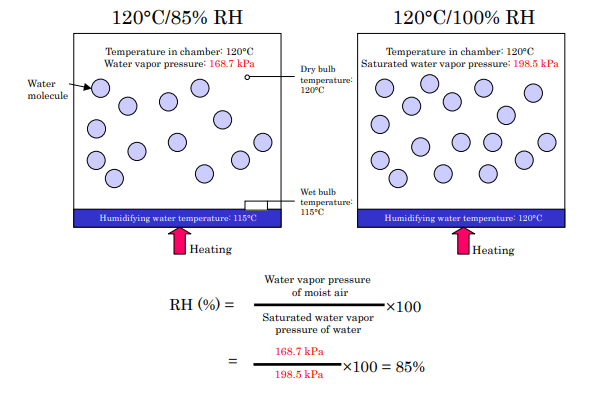
HAST relative humidity schematic diagram
EMSxchange Enables you to select a Printed Circuit Board, PCB Assembly, cable & wire harness assembly, and box-build suppliers meeting your Required Electronic Manufacturing Capability, capacity, and Certification Criteria from a global Electronic contact manufacturer base.
EMSxchange takes complete responsibility and ownership for your electronic manufacturing process and all its deliverables from contract manufacturing supplier selection to manufacturing to quality inspection to shipment and delivery to your door.
EMSxchange Electronic Manufacturing Partners Profile includes:
Argus Systems (AESPL) – PCB, PCBA, Cable Assembly, Box Build, Testing.

